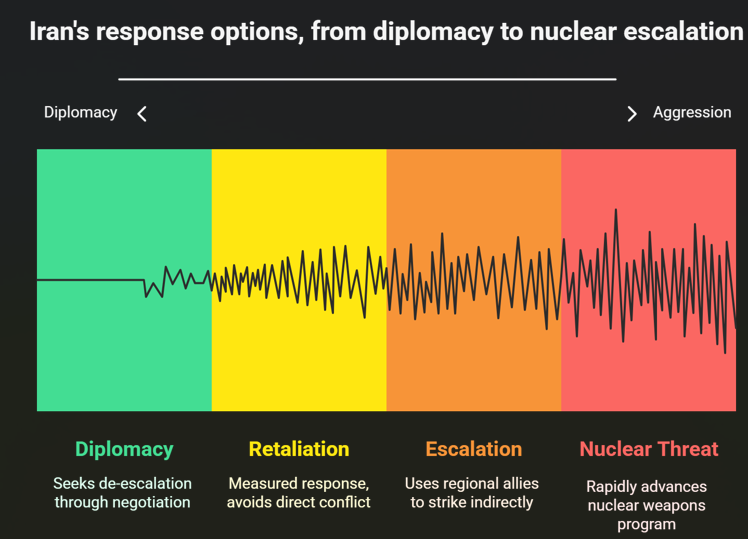War in Middle East Escalates: Critical Turning Point for Iran and Israel
War in Middle East Intensifies: Dangerous Fallout for Regional Stability
Context: Recently Israel – Iran exchanged 4 rounds of airstrikes in response to Israel’s full-scale air offensive dubbed “Operation Rising Lion” targeting Iran’s nuclear and missile infrastructure.

What Are Israel’s Objectives?
- Degrade Iranian air-defence and command infrastructure to ease future strikes on sites like Fordow or Khondab.
- Decapitate leadership of the IRGC and its Axis of Resistance (Hezbollah, Houthis, Iraqi militias) to undermine Iran’s power projection.
- Shape U.S. bargaining leverage by demonstrating Iran’s weaknesses, while avoiding a full-scale conflict or a global oil shock.
What are the possible impacts on Iran?
- Leadership attrition: At least four senior IRGC commanders, including IRGC chief Hossein Salami, are dead, disrupting operational continuity.
- Economic strain: Damage to refineries, power grids and defence plants compounds U.S. sanctions; the rial hit a 16‑month low on 14 June.
- Domestic politics: Hard‑liners in parliament argue that reformist President Masoud Pezeshkian cannot protect national security, narrowing diplomatic space.
- Regional optics: Gulf Arab capitals—including Riyadh—publicly condemned the Israeli raids, signalling a rare uptick in sympathy for Tehran.
What are India’s Choices?
- Energy security: Roughly 40 % of India’s crude imports pass the Strait of Hormuz. Delhi will lobby all parties (including Oman, Qatar) to keep the waterway open and may tap strategic reserves if premiums spike.
- Diaspora safety: Over 8 million Indians live across the Gulf and Israel; contingency plans for evacuation (similar to Operation Kaveri in Sudan, 2023) are being reviewed.
Role of Washington
- Leveraged restraint: Trump signals readiness to intervene if U.S. forces are attacked but prefers diplomacy over war.
- Back‑channel facilitation: U.S. officials work with Muscat and Doha to pursue a “freeze-for-freeze” — Iran halts strikes and enrichment while Israel pauses raids.
- Sanctions & incentives: Conditional sanctions relief is offered if Iran stands down, with a snap-back option if escalation occurs.
- Domestic consideration: Ahead of the November 2025 elections, the administration seeks a foreign policy win without putting U.S. lives at risk.
- Strategic autonomy: India enjoys strong defence ties with Israel (air‑defence, UAVs) yet cannot alienate Iran, critical for Chabahar port and access to Central Asia. Expect calibrated diplomacy: condemn civilian harm, urge restraint, avoid picking sides.
- Economic hedging: Diversify crude contracts toward Russia, Guyana and Brazil; fast‑track rupee‑dirham settlement to cushion forex shocks.
What are the Possible Endgame Scenarios?
- Managed de‑escalation – Qatari‑Omani shuttle diplomacy pauses strikes; U.S. & EU restart JCPOA‑plus talks; status quo ante minus lost IRGC leaders.
- Prolonged shadow war – Low‑intensity tit‑for‑tat inside Syria/Iraq, cyber‑hits, occasional missile flurries; nuclear issue unresolved.Regional spiral – Hezbollah or Houthis draw in Saudi‑led coalition and U.S. naval assets; oil at $150; global recession risk.
- Nuclear threshold – Iran rushes to ≥90 % enrichment, Israel considers bunker‑buster campaign; U.N. Security Council emergency session.
Background of the Recent Iran–Israel Conflict (2025)
The Iran–Israel conflict in mid-2025 marks a dangerous escalation from their longstanding shadow war, triggered by unprecedented Israeli airstrikes on Iran on June 13, 2025 — fueling fears of a full-blown regional conflict.
Immediate Trigger: The assassination of key Iranian leaders, most notably Ali Shamkhani — a senior political adviser to Supreme Leader Ayatollah Khamenei and former lead negotiator in US–Iran nuclear talks — along with several high-ranking members of the Islamic Revolutionary Guard Corps (IRGC), marks a significant decapitation strike against Iran’s security and diplomatic leadership.
Longstanding Strategic Hostility: The conflict rests on three key fault lines–
- Iran’s Nuclear Programme: Israel sees Iran’s growing capabilities as an existencial threat, marking a shift from covert operations to overt conflict.
- Proxy Wars: Iran’s support for groups like (Lebanon), Hamas (Gaza), Houthis (Yemen), and the Hashd al-Shaabi (Iraq) fuels a regional cold war that’s now turning into a direct showdown.
- Trump’s Pressure Strategy: The escalation aligns with President Trump’s aim to increase pressure on Iran to return to negotiations — while avoiding direct U.S. military involvement.
